Dupuytren contracture and what you need to know
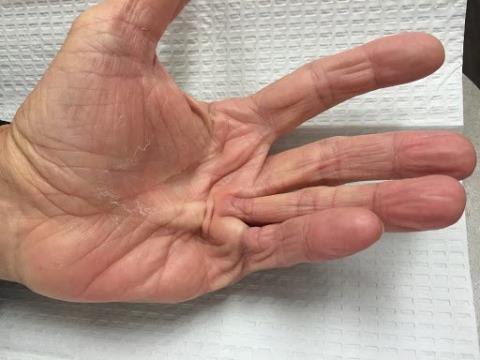
Dupuytren's contracture is a disease that progresses slowly over many years. The disease is characterized by hyperplasia of the palmar fascia and related structures. The cause is unknown, most likely due to genetic factors, common in men over 50 years old. It usually affects the little and ring fingers, or the whole hand. Join SignsSymptomsList to learn more information about Dupuyren's disease for timely detection and treatment.
content
- 1. What is the definition of Dupuytren's contracture?
- 2. Epidemiology
- 3. Symptoms of Dupuytren's contracture
- 4. Causes and pathogenesis
- 5. Risk factors for Dupuytren's contracture
- 6. Diagnosis of Dupuytren's contracture
- 7. Dupuytren's contracture treatment
- 8. Complications of Dupuytren's contracture
- 9. Post-operative care and rehabilitation
1. What is the definition of Dupuytren's contracture?
Dupuytren's contracture is the result of a disorder of the fibrous proliferation of the connective tissue. This is an inherited, benign, and chronic condition that progresses over many months and years. The result is thickening and shortening of the palmar fascia in the palm and fingers. The disease causes the fibrous connective tissue to contract vertically, causing the fingers to flex into the palm of the hand. This can make it difficult to perform daily activities such as wearing gloves, shaking hands, etc. There is currently no cure, and the cause is not clear. However, treatment can help relieve symptoms and slow the progression of the disease.
2. Epidemiology
The disease is common in people of Nordic descent, affecting 4-6% of whites worldwide. The disease rarely occurs in people from Africa, Asia.
The incidence of the disease increases with age, usually after the age of 50, most commonly between the ages of 50 and 60. Men account for 80% of cases.
Disease related family history. Almost half of the patients had a relative with the disease. The age of onset of people with both parents affected is younger than that of people with only one parent. People with a sibling with the disease are three times more likely to develop the disease.
3. Symptoms of Dupuytren's contracture
The disease progresses very slowly over many months and years. Dupuytren's spasm can occur in both hands, but one hand is more commonly affected. In which, the right hand is more often affected than the left hand.
Symptoms of the disease include:
- Nodules or lumps appear on the palms of the hands. Nodules are round or oval, flattened, firm, non-motile, 0.5 cm to 1.5 cm in diameter, with indistinct margins, painless to palpation. In rare cases, however, the nodules become red, painful, and itchy.
- Wrinkled or wrinkled skin like a dimple in the palm of your hand, fingers
- The raised fibrous cords extend from the palm to the fingers. The fibrous cord is a few mm to 1 cm wide, and feels like a wire running under the skin. Normally it feels soft, but when stretched, the fingers become firm. Unlike the nodules, the fibrous cord has a well-defined margin and is mobile on palpation. Usually the fibrous cord and the nodules lie in a straight line in the direction of the fingers.
- Bend your fingers toward the palm of your hand. This is the late stage of the disease. The most affected fingers are the little and ring fingers. The middle finger can also be affected, very rarely involving the thumb and index finger. In which, the joints that are contracted are the metatarsal joints and the interphalangeal joints near the fingers.
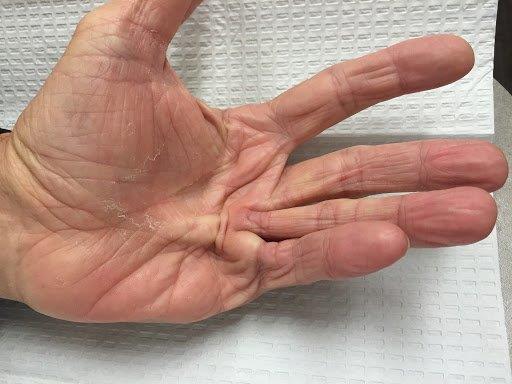
4. Causes and pathogenesis
The cause of Dupuytren's contracture is unknown. However, many findings about connective tissue and cellular changes are associated with the disease. Although it shares some features with melanoma, it is a benign progressive tumor. The disease begins with the proliferation of fibroblasts. Then there is the deposition of collagen type 3. This leads to uncontrolled proliferation of palmar fascia, causing spasm. The disease is related to a genetic condition. Many studies have shown that people with a family history have an increased risk of the disease.
5. Risk factors for Dupuytren's contracture
Some factors that increase the risk of the disease include:
- Age : Dupuytren's contracture occurs most commonly after age 50. Symptoms increase with age.
- Gender : Men are more likely to have the disease and have more severe contractures than women.
- Race : People of Nordic, Caucasian descent are at higher risk.
- Family history of the disease : According to research, people who have a father, mother, sibling or relative with the disease have a higher risk than others.
- Tobacco, alcohol : Smoking increases the risk of Dupuytren's contracture, perhaps due to microscopic changes in blood vessels caused by smoking. Alcohol abuse is also an implicated factor in the disease.
- Diabetes : People with diabetes are reported to be associated with this spasm.
- Seizures or use of antiepileptic drugs
- Body Mass Index (BMI) : People with a BMI lower than normal are reported to be associated with the disease.
- Occupations involving the hands such as craftsmen or hand injuries may be at risk for Dupuytren's contracture.
6. Diagnosis of Dupuytren's contracture
Dupuytren's contracture is diagnosed primarily on the basis of a physician's physical examination. Supportive tests are rarely needed. The characteristic clinical signs of the disease are enough for the doctor to make a diagnosis. However, it still needs to be distinguished from other diseases with similar symptoms. Consists of:
- Gun trigger finger. Unlike Dupuytren's contracture, trigger finger is often painful when flexing the fingers and inability to extend the affected fingers.
- Tendon bursitis. Symptoms are usually pain and are caused by overuse or trauma to the fingers.
- Lymphatic cyst. A small, mobile, palpable lump in the knuckles may be a lymph node
- Soft tissue tumor. Soft tissue tumors should be considered if the patient is young and has no risk factors.
6.1 Supportive laboratory tests:
Laboratory tests are not routinely used to diagnose Dupuytren's contracture. However, if there is a suspicion of diabetes in Dupuytren's patient, a rapid blood glucose test should be performed. Because there have been many reports that diabetes is associated with Dupuytren's contracture.
Ultrasound may show thickening of the palmar fascia, as well as the presence of tumors. In addition, ultrasound also supports treatment in the process of injecting substances into the lesion.
6.2 Diagnosis of histological stage of the disease
Luck in 1959 described three histological stages of Dupuytren's disease as follows:
- Proliferative stage: Characterized by random arrangement of collagen fibers. Along with that is a strong proliferation of fibroblasts.
- Involution stage: Collagen fibers are arranged along the length of the hand. Myofibroblasts predominate and congregate near collagen fibers
- Residual stage: The collagen is uniformly oriented, with little or no fibrous fibers. This phase is similar to the wound healing phase.
7. Dupuytren's contracture treatment
Treatment options include soft tissue release such as collagen injections, and fasciectomy. Because only the symptom of contracture is treated, it cannot treat the cause, so relapse after treatment is very common. Treatment is individualized based on the person's risk factors and medical history. Only symptomatic patients should be treated because all treatments have complications. Treatment modalities include:
7.1 Follow up
Follow-up is appropriate for those with no pain, no progression, minimal spasm, or no impairment of hand or finger function. Patients can be monitored in a medical facility every 6 to 12 months. Monitoring helps to assess the progress of the disease, detect signs of impaired motor function. From there, help give more accurate treatment advice.
7.2 Physiotherapy
Stretching with heat and ultrasound can be helpful in the early stages. A splint can be used to stretch the finger. Exercises should be performed several times a day. Physiotherapy exercises may be applied after surgery, including:
- Wound care
- Massage
- Passive stretching
- Exercises to improve the range of motion of the fingers
- Support brace
7.3 Injection of collagen digester (Collagenase)
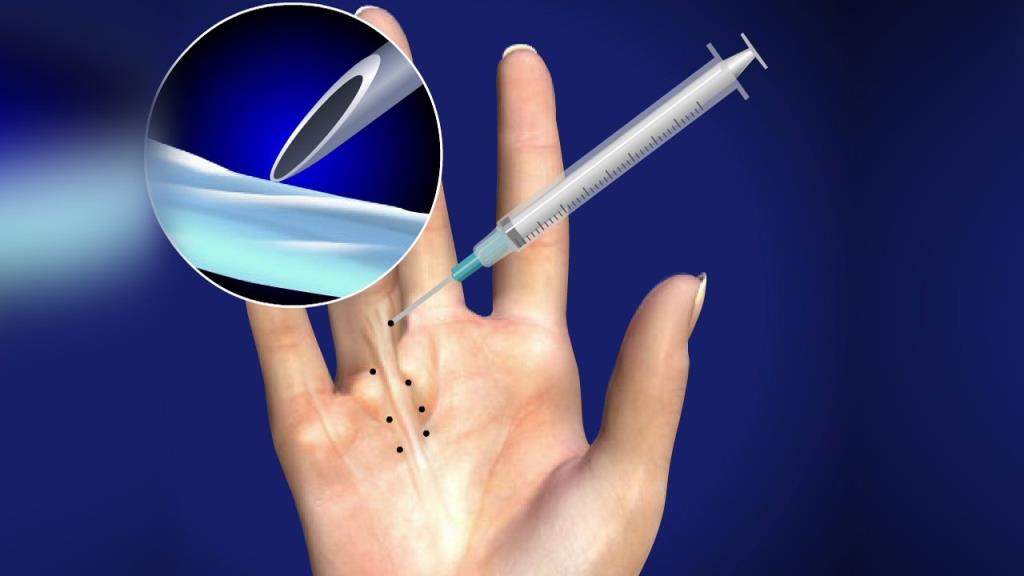
This is a minimally invasive procedure performed in a medical facility. Collagenase is injected into the fibrous band. The fibrous band is then broken through passive extension of the finger. Passive finger extension was performed at 24, 48, or 72 hours after injection. The most common complications include injection site reactions, edema, bruising, bleeding, and pain. More serious reactions include tendon rupture and regional pain syndrome. These complications tend to be self-limited and resolve quickly, leaving no sequelae. Collagenase injections have been shown to reduce spasms by 75%, with a 35% recurrence rate.
7.4 Corticosteroid injections
Corticosteroid injections may improve the size of the nodule in some Dupuytren patients. Injecting at an early stage of the nodule without joint contracture can prevent disease progression. However, they are not effective in all patients and recur in up to 50%. Corticosteroid injections can lead to fat atrophy, change in skin color, and potentially rupture of tendons.
7.5 Surgery
The goal of surgery is to remove the retractile fascia, which helps to prevent disease progression. Surgery involves removing part or all of the palmar fascia. The recurrence rate is 30% at 1 to 2 years, 15% at 3 to 5 years, and less than 10% at ten years.
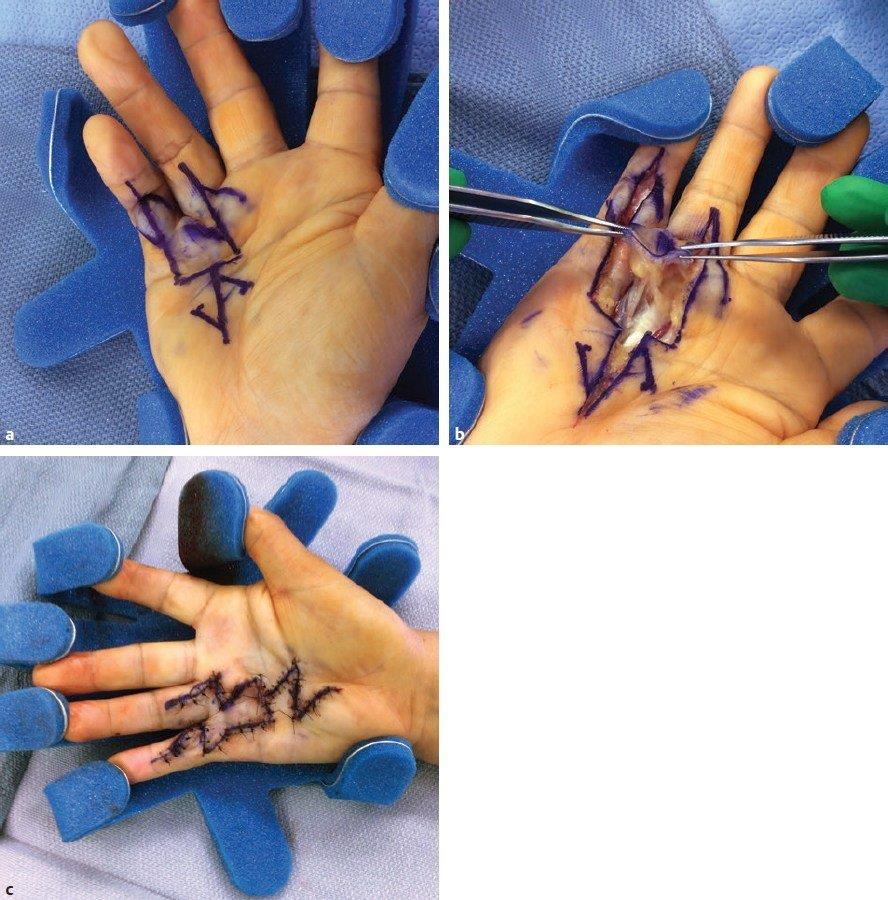
An illustration of a Dupuytren's contracture surgery
7.6 Other treatments
Radiation therapy, tamoxifen, 5 fluorouracil, imiquimod and botulinum toxin are being tested.
8. Complications of Dupuytren's contracture
Complications of surgical treatment include margin necrosis, hematoma, nerve damage, finger ischemia, infection, swelling, recurrence or acute flare after surgery. Finger anemia can be caused by direct damage to the blood vessels that supply the finger. In addition, damage to blood vessels is also caused by the prolonged retraction of the finger. Dupuytren's flare response is redness, pain, diffuse swelling, tenderness, and stiffness. Treatment of this complication includes steroids, sympathetic block, and A1 pulley release.
9. Post-operative care and rehabilitation
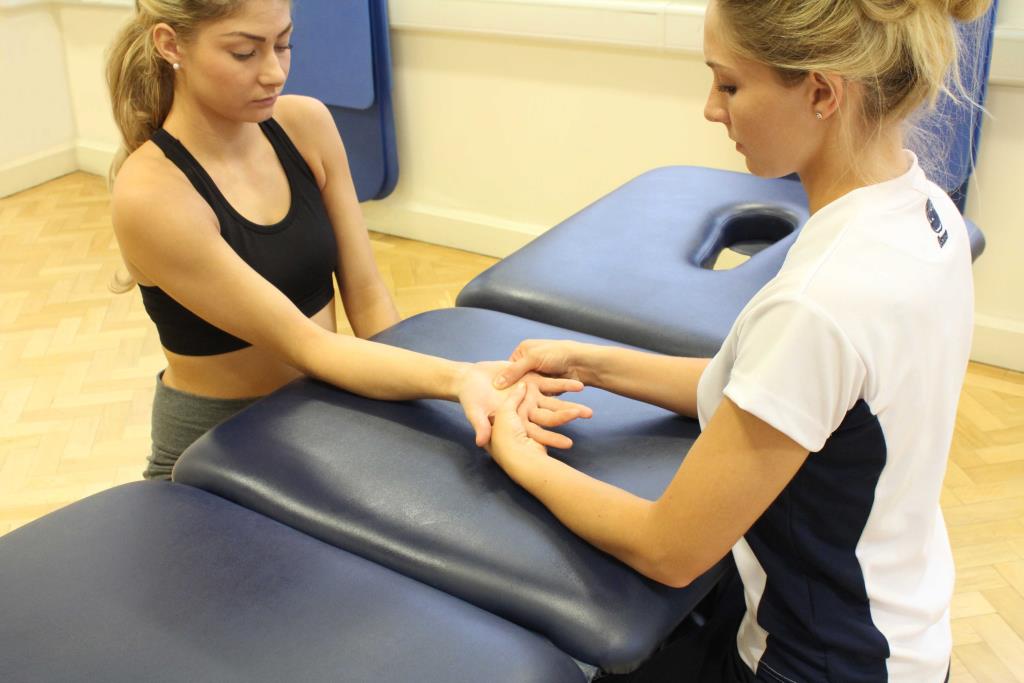
After surgery, the patient received hand therapy to maintain the range of motion of the hand. Finger splints should be used together. Physical therapy should be done for at least 3 months to prevent spasms. The maximum effect of surgery is not immediate, but only apparent after 6-8 weeks.
Relapse should be prevented by controlling blood sugar, abstaining from alcohol, and stopping smoking.
Through the article, SignsSymptomsList hopes to have provided you with more useful information. If you have the above signs and symptoms, you should see a rheumatologist for a diagnosis. The condition and progression of the disease varies from day to day. Therefore, patients visit their doctor periodically to monitor their disease status and response to treatment. In addition, patients need to improve their lifestyle to support the most effective treatment.
See also related articles: